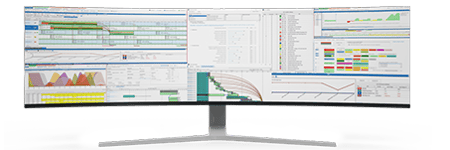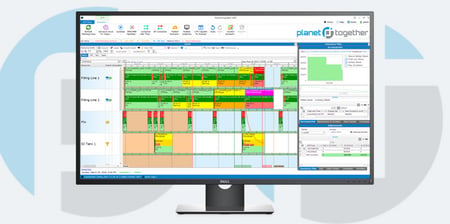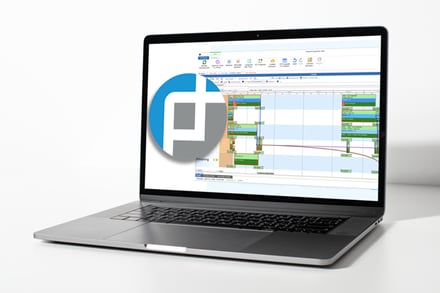Optimize Efficiency and Streamline Workflow
In pharmaceutical manufacturing, every step in the production process must be carefully coordinated to ensure quality, safety, and compliance. As a Production Scheduler, your role is critical in balancing these requirements while optimizing efficiency to keep production on track.
The integration of advanced scheduling solutions like PlanetTogether with powerful enterprise systems such as SAP, Oracle, Microsoft, Kinaxis, or Aveva is becoming an essential strategy to meet these demands. This integration can streamline workflows, improve resource allocation, and enhance overall productivity, all while minimizing the risk of errors and delays.

The Unique Challenges of Production Scheduling in Pharmaceutical Manufacturing
Pharmaceutical manufacturing is unlike any other industry. Here, production scheduling must address strict regulatory requirements, stringent quality standards, and often complex processes involving specialized equipment and skilled labor. Schedulers must manage:
Complex production lines with a mix of batch and continuous processes.
Stringent timelines to ensure that products are delivered without delay.
Stringent quality control requirements, where any deviation could lead to product recalls, fines, or reputational damage.
Resource constraints, from raw materials and equipment to skilled labor.
Compliance with good manufacturing practices (GMP) and other regulatory standards.
These challenges require production schedulers to make informed, real-time decisions based on accurate data. Integrating PlanetTogether with major ERP or planning systems such as SAP, Oracle, Microsoft, Kinaxis, or Aveva can offer significant benefits by enhancing data accessibility, streamlining workflows, and improving the accuracy and flexibility of your scheduling efforts.
![]()

Why Integrate PlanetTogether with ERP Systems?
PlanetTogether is an advanced production scheduling solution that allows manufacturers to visualize production schedules, manage bottlenecks, and maximize resource utilization. Integrating it with ERP systems like SAP, Oracle, Microsoft, Kinaxis, or Aveva enables seamless data sharing, improved coordination, and real-time visibility across departments. This integration transforms PlanetTogether into a more powerful tool, enabling it to draw on ERP data for an even more accurate view of production dynamics. The benefits are numerous:
Real-Time Data Synchronization: Integrated systems allow PlanetTogether to access live data from ERP platforms, providing production schedulers with the latest inventory levels, machine availability, and labor status. This ensures that scheduling decisions are based on the most current information, reducing the risk of scheduling conflicts or idle time.
Streamlined Communication: An integrated system eliminates the need for manual data transfers between departments. With PlanetTogether connected to ERP systems, all relevant departments—from procurement and production to sales and distribution—operate on the same data, enhancing cross-departmental communication.
Enhanced Resource Management: PlanetTogether’s integration with ERPs enables better tracking of resource availability, from raw materials and ingredients to labor and equipment. This means production schedulers can easily identify bottlenecks and allocate resources more efficiently.
Improved Flexibility and Responsiveness: In a highly dynamic environment like pharmaceutical manufacturing, being able to adapt to last-minute changes is essential. Integration allows schedulers to quickly adjust schedules in response to unexpected disruptions—such as equipment failures, inventory shortages, or urgent orders—without compromising quality or compliance.
Optimized Batch Processing and Production Runs: Scheduling in the pharmaceutical industry often involves coordinating batch production, where small changes in timing or sequence can impact efficiency and compliance. Integration allows for better sequencing of production runs based on real-time data, minimizing setup times, reducing waste, and maximizing output.

Key Features of PlanetTogether’s Integration with ERP Systems
By integrating PlanetTogether with ERP systems like SAP, Oracle, Microsoft, Kinaxis, or Aveva, Production Schedulers gain access to advanced features that can significantly enhance their workflows. Here are a few features that make a difference in pharmaceutical manufacturing:
Advanced Constraint Management: PlanetTogether’s advanced scheduling algorithms can factor in real-time constraints such as equipment capacity, labor availability, and regulatory compliance requirements. When integrated with ERP data, these constraints can be dynamically adjusted, allowing schedules to remain flexible and efficient under changing conditions.
Real-Time Dashboards and Analytics: With data from ERP systems feeding into PlanetTogether, schedulers can benefit from real-time dashboards that provide a holistic view of production activities. Advanced analytics tools can track KPIs such as on-time delivery rates, production costs, and resource utilization, providing insights that help schedulers optimize performance over time.
Automated Notifications and Alerts: An integrated system can automatically trigger alerts or notifications when a potential issue arises, such as a delay in raw material availability or a drop in machine performance. This allows schedulers to proactively address issues before they impact production.
Seamless Compliance Tracking: Pharmaceutical manufacturing requires strict adherence to GMP and other regulations. With ERP integration, PlanetTogether can track compliance-related data, helping schedulers ensure that every production batch meets regulatory standards.

Practical Steps for Implementing PlanetTogether-ERP Integration
To achieve the benefits of PlanetTogether-ERP integration, it’s essential to follow a structured implementation process. Here are some steps to consider:
Assess Your Current Systems and Identify Integration Points: Begin by evaluating your current ERP system and determining which data points (such as inventory levels, production orders, and labor schedules) should be linked with PlanetTogether. Identify any potential compatibility issues and consult with your IT team to address them.
Set Clear Objectives: Define what you aim to achieve through the integration, such as reduced lead times, improved on-time delivery rates, or better resource utilization. Clear goals will help guide the integration process and measure its success.
Work with Experienced Partners: Integrating PlanetTogether with an ERP system can be complex, especially in a highly regulated industry. Work with experts who understand both the technical and operational requirements of pharmaceutical manufacturing. Many ERP providers offer integration support, and PlanetTogether has consultants who can guide you through the process.
Train Your Team: Ensure that your team understands the features and benefits of the integrated system. Training production schedulers on how to use PlanetTogether’s real-time data and advanced features will help them make the most of the system.
Monitor and Optimize: Once the integration is live, continuously monitor performance metrics and gather feedback from schedulers. Use this data to refine your scheduling processes and make adjustments as necessary.

Measuring Success: Key Performance Indicators (KPIs) for Production Schedulers
As you integrate PlanetTogether with ERP systems, it’s important to measure success and ensure that the integration is delivering tangible benefits. Here are some KPIs that can help you track the effectiveness of the integration:
On-Time Delivery Rate: The percentage of production orders completed on or before the scheduled delivery date. A higher on-time delivery rate indicates that the integration is helping to streamline scheduling and reduce delays.
Cycle Time Reduction: The time required to complete a production cycle from start to finish. Reduced cycle times indicate that schedules are more efficient and resources are being used optimally.
Resource Utilization Rate: The percentage of available labor, equipment, and materials that are actively being used in production. Higher utilization rates suggest that scheduling and resource allocation are well-optimized.
Waste Reduction: In pharmaceutical manufacturing, waste reduction is crucial for both cost savings and environmental sustainability. Track reductions in waste to measure the impact of more efficient scheduling on material usage.
Inventory Turnover: The rate at which raw materials or finished products are used or sold. High turnover rates indicate efficient production scheduling and effective demand planning.
The Path Forward
Integrating PlanetTogether with ERP systems like SAP, Oracle, Microsoft, Kinaxis, or Aveva represents a powerful step toward optimizing efficiency and streamlining workflow in pharmaceutical manufacturing. For Production Schedulers, this integration can unlock significant benefits, from real-time data synchronization and enhanced resource management to improved flexibility and compliance tracking. By following a structured implementation process and tracking key performance metrics, you can ensure that the integration delivers measurable improvements in productivity, quality, and efficiency.
As the pharmaceutical industry continues to evolve, production schedulers must be equipped with the right tools and systems to keep pace. The integration of advanced scheduling solutions with enterprise platforms is a strategic investment that not only improves day-to-day operations but also strengthens your facility's ability to adapt to future challenges.
Are you ready to take your manufacturing operations to the next level? Contact us today to learn more about how PlanetTogether can help you achieve your goals and drive success in your industry.
Topics: PlanetTogether Software, Real-Time Data Synchronization, Improved Flexibility and Responsiveness, Integrating PlanetTogether, Streamlined Communication, Automated Notifications and Alerts, Pharmaceutical Manufacturing, Real-Time Dashboards and Analytics, Optimized Batch Processing and Production Runs, Advanced Constraint Management, Seamless Compliance Tracking





















LEAVE A COMMENT